Shensheng Han
Hyperspectral image reconstruction by deep learning with super-Rayleigh speckles
Feb 26, 2025Abstract:Ghost imaging via sparsity constraints (GISC) spectral camera modulates the three-dimensional (3D) hyperspectral image into a two-dimensional (2D) compressive image with speckles in a single shot. It obtains a 3D hyperspectral image (HSI) by reconstruction algorithms. The rapid development of deep learning has provided a new method for 3D HSI reconstruction. Moreover, the imaging performance of the GISC spectral camera can be improved by optimizing the speckle modulation. In this paper, we propose an end-to-end GISCnet with super-Rayleigh speckle modulation to improve the imaging quality of the GISC spectral camera. The structure of GISCnet is very simple but effective, and we can easily adjust the network structure parameters to improve the image reconstruction quality. Relative to Rayleigh speckles, our super-Rayleigh speckles modulation exhibits a wealth of detail in reconstructing 3D HSIs. After evaluating 648 3D HSIs, it was found that the average peak signal-to-noise ratio increased from 27 dB to 31 dB. Overall, the proposed GISCnet with super-Rayleigh speckle modulation can effectively improve the imaging quality of the GISC spectral camera by taking advantage of both optimized super-Rayleigh modulation and deep-learning image reconstruction, inspiring joint optimization of light-field modulation and image reconstruction to improve ghost imaging performance.
Cross-Dataset Generalization in Deep Learning
Oct 15, 2024
Abstract:Deep learning has been extensively used in various fields, such as phase imaging, 3D imaging reconstruction, phase unwrapping, and laser speckle reduction, particularly for complex problems that lack analytic models. Its data-driven nature allows for implicit construction of mathematical relationships within the network through training with abundant data. However, a critical challenge in practical applications is the generalization issue, where a network trained on one dataset struggles to recognize an unknown target from a different dataset. In this study, we investigate imaging through scattering media and discover that the mathematical relationship learned by the network is an approximation dependent on the training dataset, rather than the true mapping relationship of the model. We demonstrate that enhancing the diversity of the training dataset can improve this approximation, thereby achieving generalization across different datasets, as the mapping relationship of a linear physical model is independent of inputs. This study elucidates the nature of generalization across different datasets and provides insights into the design of training datasets to ultimately address the generalization issue in various deep learning-based applications.
Micro-Vibration Modes Reconstruction Based on Micro-Doppler Coincidence Imaging
Aug 30, 2022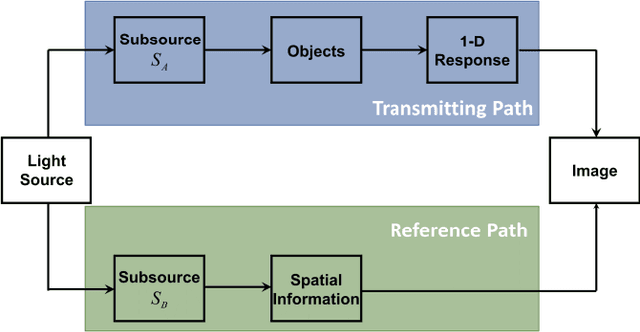

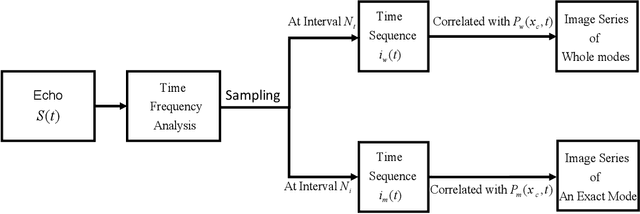

Abstract:Micro-vibration, a ubiquitous nature phenomenon, can be seen as a characteristic feature on the objects, these vibrations always have tiny amplitudes which are much less than the wavelengths of the sensing systems, thus these motions information can only be reflected in the phase item of echo. Normally the conventional radar system can detect these micro vibrations through the time frequency analyzing, but these vibration characteristics can only be reflected by time-frequency spectrum, the spatial distribution of these micro vibrations can not be reconstructed precisely. Ghost imaging (GI), a novel imaging method also known as Coincidence Imaging that originated in the quantum and optical fields, can reconstruct unknown images using computational methods. To reconstruct the spatial distribution of micro vibrations, this paper proposes a new method based on a coincidence imaging system. A detailed model of target micro-vibration is created first, taking into account two categories: discrete and continuous targets. We use the first-order field correlation feature to obtain objective different micro vibration distribution based on the complex target models and time-frequency analysis in this work.
Hyperspectral image reconstruction for spectral camera based on ghost imaging via sparsity constraints using V-DUnet
Jun 28, 2022
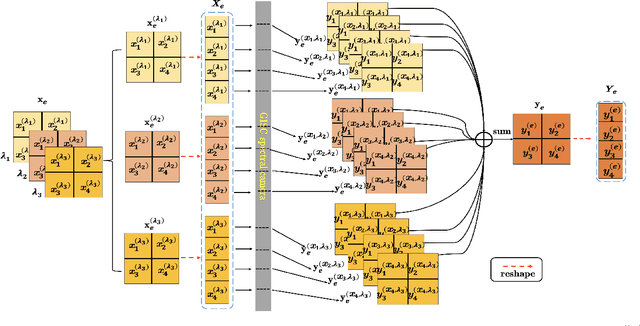
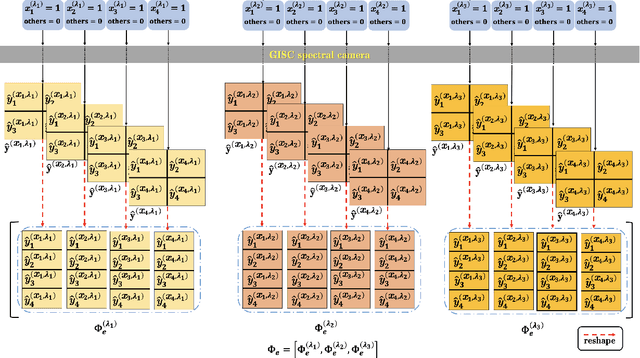
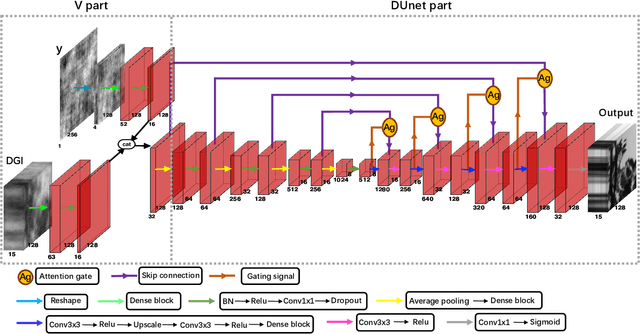
Abstract:Spectral camera based on ghost imaging via sparsity constraints (GISC spectral camera) obtains three-dimensional (3D) hyperspectral information with two-dimensional (2D) compressive measurements in a single shot, which has attracted much attention in recent years. However, its imaging quality and real-time performance of reconstruction still need to be further improved. Recently, deep learning has shown great potential in improving the reconstruction quality and reconstruction speed for computational imaging. When applying deep learning into GISC spectral camera, there are several challenges need to be solved: 1) how to deal with the large amount of 3D hyperspectral data, 2) how to reduce the influence caused by the uncertainty of the random reference measurements, 3) how to improve the reconstructed image quality as far as possible. In this paper, we present an end-to-end V-DUnet for the reconstruction of 3D hyperspectral data in GISC spectral camera. To reduce the influence caused by the uncertainty of the measurement matrix and enhance the reconstructed image quality, both differential ghost imaging results and the detected measurements are sent into the network's inputs. Compared with compressive sensing algorithm, such as PICHCS and TwIST, it not only significantly improves the imaging quality with high noise immunity, but also speeds up the reconstruction time by more than two orders of magnitude.
 Add to Chrome
Add to Chrome Add to Firefox
Add to Firefox Add to Edge
Add to Edge